
Understanding LandMagic’s Application Filters
Objectives
Overview
We are going to be discussing the filtering sections that LandMagic’s applications use to help its users find the data they need. We will use the Job List application as an example for this article.
Note: The Job List application is located under CropCare.
LandMagic consists of multiple products or modules like CropCare. Within these modules are multiple applications like Job List . These applications have been built to be as consistent as possible regarding their features, structure and layout. The majority of LandMagic’s applications have a filtering section located at the top of the main application.
The filtering section contains different types of elements. These elements have different behaviors and purposes. Below we will discuss the different types of elements, how they work, and what their purposes are.
LandMagic’s Filtering Components
Using the Job List application as an example for this article, let’s first take a look at its basic structure. The first section you will notice and the topic of this article is the filtering section located at the very top of the application.

The following and final section of the application is the GridView located directly under the filtering section. The GridView displays our datasets.

When we navigate to the Job List or any other application, the filters are typically set to default values. If we take a look at the previous filtering section screenshot we will notice that the dropdown lists contain values like - -Select- -, - -Select/Type- -, - -Yes/No- - etc… These values are default values and have no effect on the data being displayed in the GridView. Therefore the GridView is displaying ALL possible data.
Note: The screenshot of the GridView above is only showing two datasets. The other 82 datasets have been removed from the image to keep the image at a reasonable size to fit in this article.
The purpose of the Filtering section is to help us find the data that we are looking for in the easiest possible way. Each filter in the filtering section corresponds to a data column in the GridView as seen below.
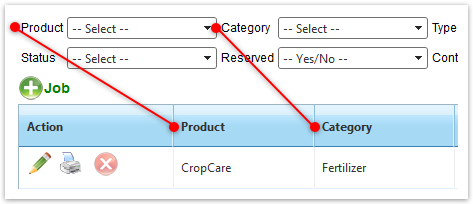
Instances will occur when we will want to find specific datasets based on certain criteria.
Example 1:
Using our Job List application, we want to find all datasets under the Product LandMaster. If we click on the Product dropdown list we will see a list of all the LandMagic products. Let’s click on LandMaster to only display our datasets in the GridView that are associated with the LandMaster product.
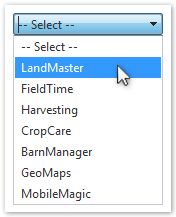
After selecting LandMaster from the Product dropdown list the GridView is automatically updated. The GridView removes all datasets that are NOT associated with the LandMaster product. Notice now that our two viewable datasets in the below screenshot display LandMaster in their Product column.

Automatic vs. Manual Filtering
There is an important difference in functionality to mention at this point in the article. In example 1 we selected LandMaster from the Product dropdown list inside the Job List application. When this action was taken, note the GridView AUTOMATICALLY updated the data after the selection was made in the dropdown list. As mentioned before at the beginning of this article, LandMagic’s features, structure and layout have been designed to be as consistent as possible for ease of use. However each application within LandMagic does occasionally function in slightly different ways. NOT ALL GridViews will automatically update when a filter is changed in the filter section. In some filter sections, we will have to set all our desired filters and then click the Search button in order to update the GridView with the filtered results.
Dependent Dropdown Lists
In some filter sections like in the Job List application, some dropdown lists are dependent on other dropdown lists. Another way to explain this is that dropdown list A is an actual filter for dropdown list B.
Example 2:
In this example we have clicked on the Type dropdown list. We notice that the dropdown list is empty. The reason for this is that the Type dropdown list is reliant on the Category dropdown list. Notice that the Category dropdown list is still displaying a default value of - - Select - -. In this particular instance we CANNOT select a Type without first selecting a Category. These dependent dropdown lists are located throughout LandMagic. Their use is based on the data structure and the applications functionality.
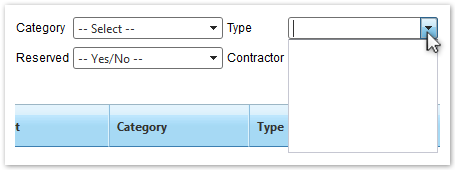
After clicking on the Category dropdown list and selecting Administration we will notice that the Type dropdown list is then populated with all the Type data that is under the Administration Category. Also, the GridView is AUTOMATICALLY updated to show only the datasets that are associated with the Category Administration. Clicking on Labor under the Type dropdown list will then automatically update the GridView to show only the datasets that are associated with the Type Labor.
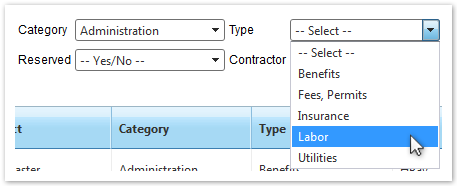
Below you will notice the updated GridView using the selected criteria. Also, notice that the filters, Category and Type match the datasets Category and Type columns.
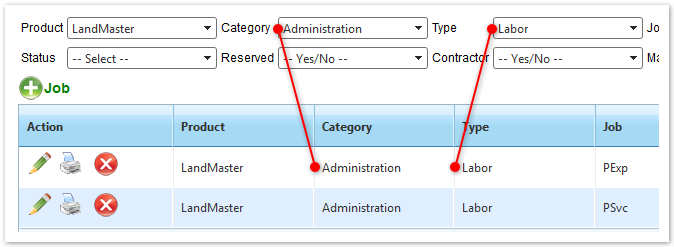
Textbox Filters
The last element in the filtering sections is a textbox. A textbox is used for manual user input. A textbox will NOT automatically update the GridView when a value is entered into its field. After we enter a value into the textbox field we must click on the Search button in order to update the GridView.
Example 3:
We will be using the Work Order List application in CropCare for this example. Below you will notice we have a textbox called Work Order No. This textbox corresponds to the Work Order No. column in the Work Order List GridView.
![]()
Because the textbox does not provide us a list of all the work order numbers like a dropdown list we must know the exact work order number in order to utilize the textbox filter. If we enter a value that does not exist and click search, the GridView will return no results. If we enter an existing value the GridView will return that single record as seen below. Notice that the Work Order No. entered in the textbox matches the returned dataset value in the GridView.
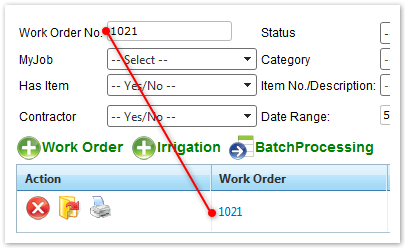
Article ID: 3
Created On: Apr 30, 2013 at 4:21 PM
Last Updated On: May 1, 2013 at 4:49 PM
Online URL: http://kb.landmagic.com/article.php?id=3